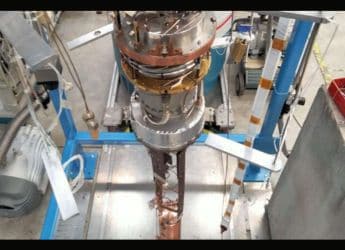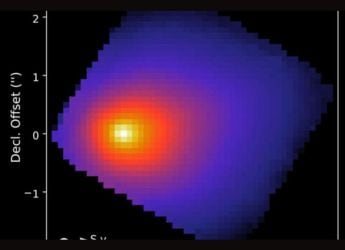- Home
- Science
- Science News
- Nasa's Dawn Spacecraft Nears Encounter With Dwarf Planet Ceres
Nasa's Dawn Spacecraft Nears Encounter With Dwarf Planet Ceres

The mission aims to shed light on the origins of the solar system 4.5 billion years ago, from its "rough and tumble environment of the main asteroid belt between Mars and Jupiter," said mission director Marc Rayman of Nasa's Jet Propulsion Laboratory (JPL).
Already scientists are intrigued by the appearance of two bright spots on Ceres.
"What are they? At this point, the clearest answer is that the answer is unknown," Rayman wrote on his blog.
The dwarf planet, which has an average diameter of 590 miles (950 kilometres), makes a full rotation every nine hours, and Nasa is hoping for a wealth of data once the spacecraft's orbit begins.
"Dawn is about to make history," said Robert Mase, project manager for the Dawn mission at Nasa JPL in Pasadena, California.
"Our team is ready and eager to find out what Ceres has in store for us."
Experts will be looking for signs of geologic activity, via changes in these bright spots, or other features on Ceres' surface over time.
The latest images came from Dawn when it was 25,000 miles (40,000 kilometres) away on February 25.
The celestial body was first spotted by Sicilian astronomer Father Giuseppe Piazzi in 1801.
"Ceres was initially classified as a planet and later called an asteroid. In recognition of its planet-like qualities, Ceres was designated a dwarf planet in 2006, along with Pluto and Eris," Nasa said.
Ceres is named after the Roman goddess of agriculture and harvests.
The spacecraft on its way to circle it was launched in September 2007.
First, Dawn explored the giant asteroid Vesta for 14 months in 2011 and 2012, then made its way toward Ceres.
"This two-stop tour of our solar system is made possible by Dawn's ion propulsion system, its three ion engines being much more efficient than chemical propulsion," Nasa said.
The exploration of Vesta and Ceres helps scientists understand how objects form in space.
"Both Vesta and Ceres were on their way to becoming planets, but their development was interrupted by the gravity of Jupiter," said Carol Raymond, deputy project scientist at JPL.
"These two bodies are like fossils from the dawn of the solar system, and they shed light on its origins."
Jim Green, director of Nasa's Planetary Science Division, said he hopes Dawn will "contribute significant breakthroughs in our understanding of how the solar system formed."
Nasa has partnered with the German Aerospace Center, Max Planck Institute for Solar System Research, Italian Space Agency and Italian National Astrophysical Institute on the mission.
Next year, the US space agency plans to launch its Origins-Spectral Interpretation-Resource Identification-Security-Regolith Explorer (OSIRIS-REx) spacecraft, to "study a large asteroid in unprecedented detail and return samples to Earth," Nasa said.
Catch the latest from the Consumer Electronics Show on Gadgets 360, at our CES 2026 hub.
Related Stories
- Samsung Galaxy Unpacked 2025
- ChatGPT
- Redmi Note 14 Pro+
- iPhone 16
- Apple Vision Pro
- Oneplus 12
- OnePlus Nord CE 3 Lite 5G
- iPhone 13
- Xiaomi 14 Pro
- Oppo Find N3
- Tecno Spark Go (2023)
- Realme V30
- Best Phones Under 25000
- Samsung Galaxy S24 Series
- Cryptocurrency
- iQoo 12
- Samsung Galaxy S24 Ultra
- Giottus
- Samsung Galaxy Z Flip 5
- Apple 'Scary Fast'
- Housefull 5
- GoPro Hero 12 Black Review
- Invincible Season 2
- JioGlass
- HD Ready TV
- Laptop Under 50000
- Smartwatch Under 10000
- Latest Mobile Phones
- Compare Phones
- OPPO Reno 15 Pro Max
- Honor Win RT
- Honor Win
- Xiaomi 17 Ultra Leica Edition
- Xiaomi 17 Ultra
- Huawei Nova 15
- Huawei Nova 15 Pro
- Huawei Nova 15 Ultra
- Asus ProArt P16
- MacBook Pro 14-inch (M5, 2025)
- OPPO Pad Air 5
- Huawei MatePad 11.5 (2026)
- Xiaomi Watch 5
- Huawei Watch 10th Anniversary Edition
- Acerpure Nitro Z Series 100-inch QLED TV
- Samsung 43 Inch LED Ultra HD (4K) Smart TV (UA43UE81AFULXL)
- Asus ROG Ally
- Nintendo Switch Lite
- Haier 1.6 Ton 5 Star Inverter Split AC (HSU19G-MZAID5BN-INV)
- Haier 1.6 Ton 5 Star Inverter Split AC (HSU19G-MZAIM5BN-INV)
















